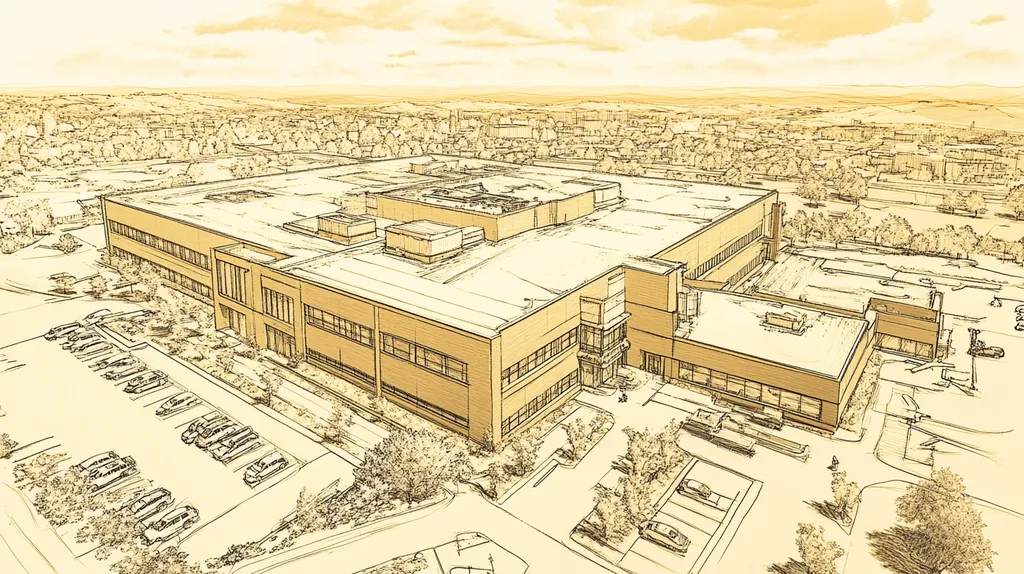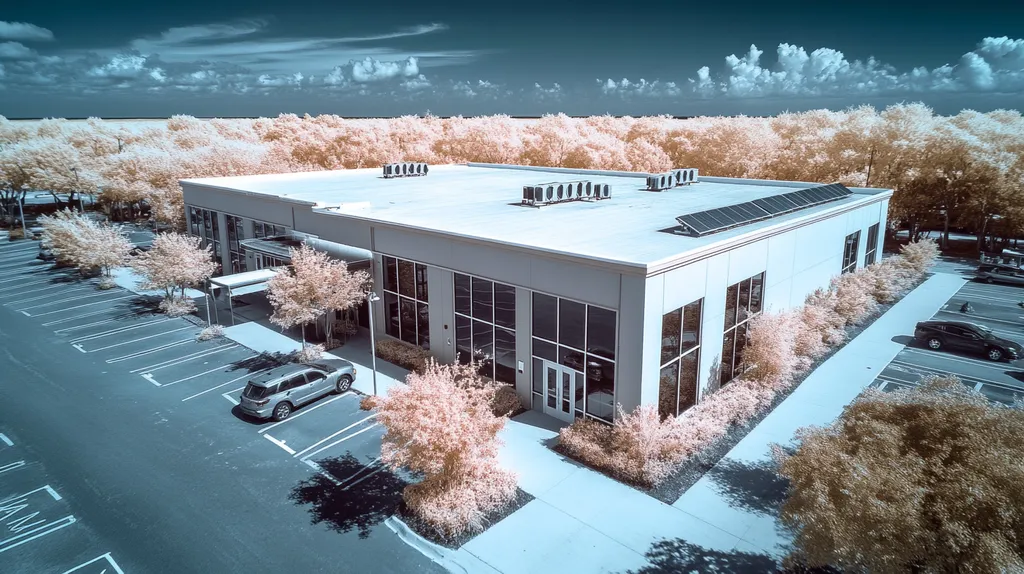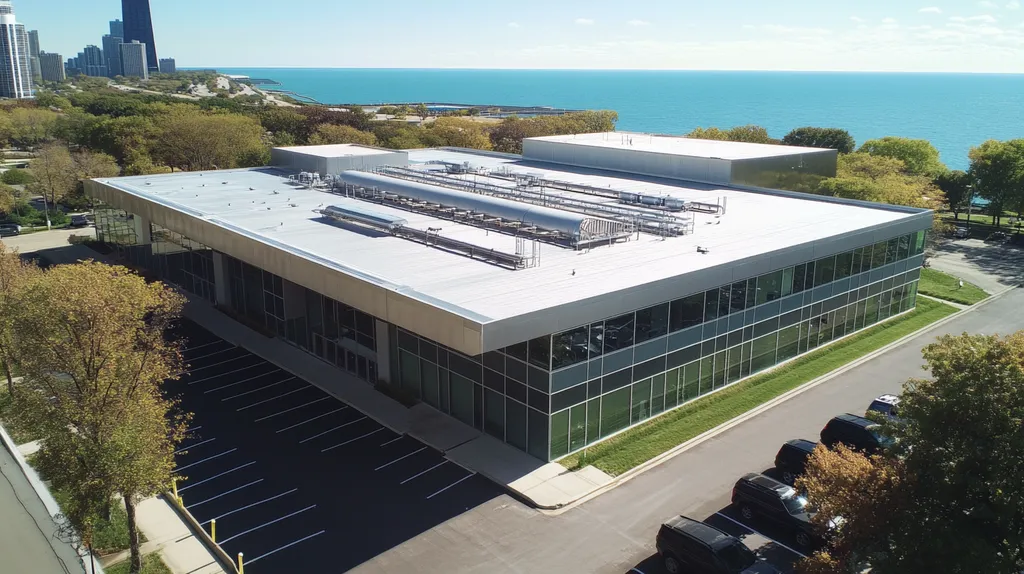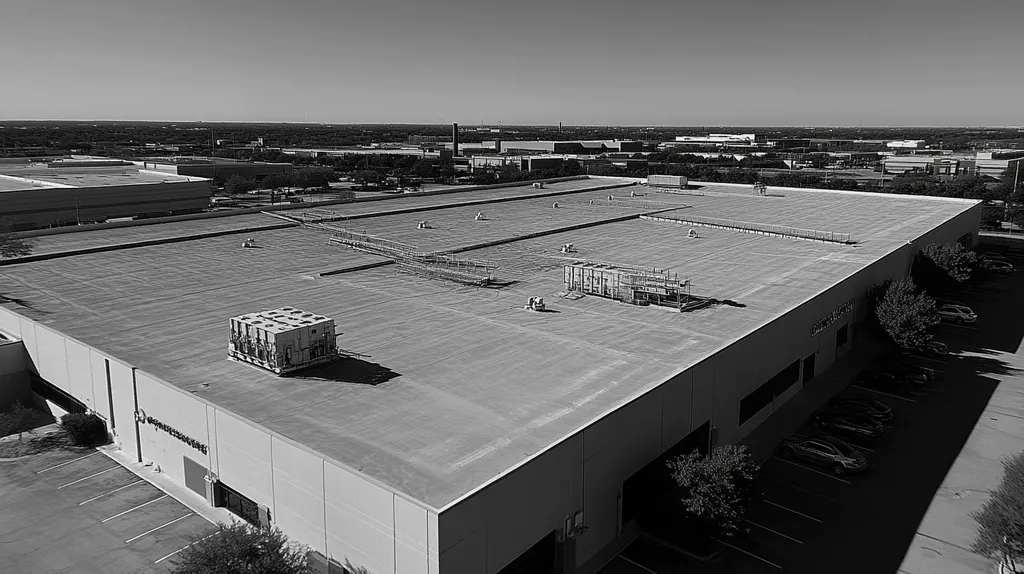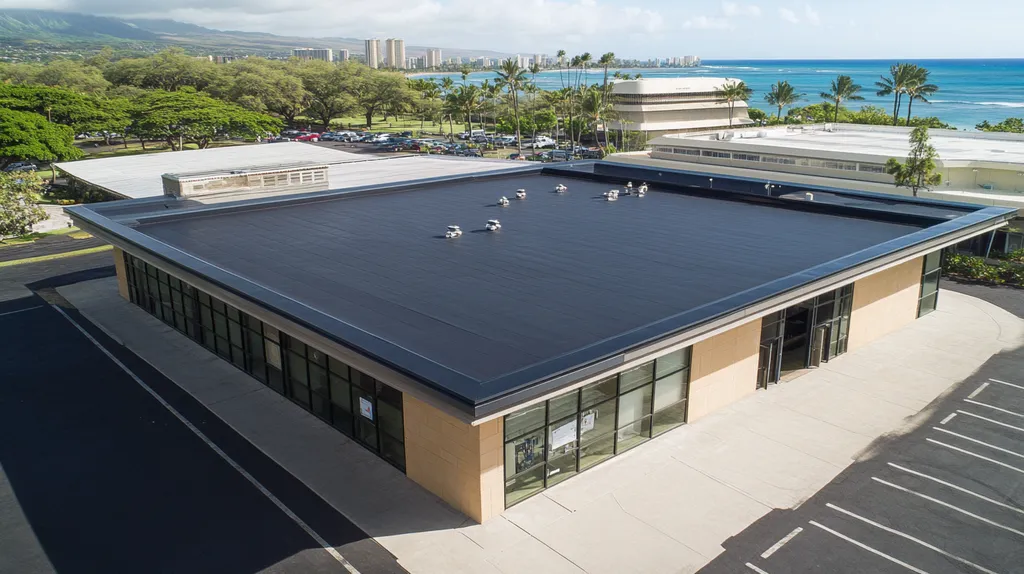Commercial property owners lose billions annually due to pest-related structural damage, with compromised roofing systems being a primary entry point for infestations.
Despite these risks, widespread misconceptions about roof design continue to leave buildings vulnerable to pest intrusion, significantly impacting both maintenance costs and property values.
This article examines common industry myths surrounding commercial roof design for pest deterrence, providing evidence-based solutions that facility managers can implement to protect their investments.
SECTION 1: COMMON MISCONCEPTIONS
Facility managers often operate under misconceptions that can severely compromise both their buildings’ integrity and pest management efforts. Neglecting crucial elements like vent and pipe openings can create entryways for pests, leading to costly infestations. Additionally, the belief that all roofs are equivalent can result in poor decision-making regarding materials and design. By addressing these issues, facility managers can enhance pest deterrence and extend the lifespan of roofing systems.
Ignoring Vent and Pipe Openings
One of the most critical oversights in commercial roofing is the disregard for vent and pipe openings. Many facility managers underestimate the role these entry points play in pest control. However, even small gaps can turn into significant vulnerabilities, providing pests with easy access to the building’s interior.
In fact, pest control professionals report that common entry points like vent stacks are responsible for a notable percentage of infestations. Proper sealing and screening of these openings is essential to blocking pests while still allowing necessary airflow. Without proactive measures, long-term expenses related to pest control and structural damage can escalate significantly.
Conducting regular inspections and implementing strategic sealing actions is critical for maintaining a pest-resistant roof. This attention ensures that even minor flaws do not jeopardize the entire roofing system. Facility managers should recognize the vital role these seemingly minor features play in a robust roofing strategy.
Ultimately, addressing vent and pipe openings is a fundamental part of commercial roof design that directly influences the effectiveness of pest management.
Believing All Roofs Are Equal
A prevalent misconception is that all roofs are created equal, which can lead to misguided choices regarding both materials and design. Different roofing systems offer varying levels of protection against pests and environmental conditions.
For example, low-slope roofs typically require distinct maintenance practices compared to steep-slope roofs. Facility managers must thoughtfully select roofing materials that deter pests while also being durable enough to withstand local weather patterns. A poor choice in roofing system could not only attract pests but can also lead to significant structural damage.
This misconception may also result in insufficient allocation of resources for maintenance and inspections. Property owners might overlook the unique needs of their roofing system, leading to increased risks for pest infestations. Investing in a roof specifically designed for optimal performance can significantly reduce these risks.
Recognizing that each roofing system presents its own challenges and benefits is crucial for effective management and long-term sustainability.
Overlooking Tree Proximity
The presence of trees near commercial buildings is often a significant but overlooked factor in roofing decisions. Facility managers may underestimate how nearby trees can contribute to pest issues. Accumulated leaves, branches, and debris can turn roofs into breeding grounds for pests while also damaging roofing materials.
For example, overhanging branches can cause wear on roofing systems, while fallen leaves can trap moisture, leading to mold growth and attracting insects. Regular tree maintenance—such as trimming branches and clearing debris—is essential for keeping roofs in ideal condition.
Facility managers should also be aware of the types of trees near their roofs. Certain species may attract specific pests that threaten the building’s integrity. By proactively managing tree proximity, property owners can strengthen their roofing systems and improve pest deterrence strategies.
In conclusion, recognizing and addressing tree proximity is vital for maintaining both the roofing system’s integrity and effective pest management.
SECTION 2: PRACTICAL IMPLICATIONS
Pest deterrence in commercial roof design is not just an added benefit; it’s a necessity. Ignoring pest risks can lead to significant structural damage, resulting in expensive emergency repairs. Research shows that pest-related damage accounts for around 20% of total building maintenance costs. Failing to address these issues not only compromises the integrity of the property but can also pose safety hazards for occupants and staff.
Structural Damage from Pests
Pests, particularly rodents and insects, can severely damage commercial roofs. For instance, termites can silently consume structural supports, leading to catastrophic failures down the line. Each year, businesses face millions of dollars in repair costs due to these hidden infestations that often go unnoticed until it’s too late.
To mitigate these risks, it’s essential to install protective barriers and choose roofing materials wisely. Effective designs typically feature sloped surfaces and sealed joints, reducing the likelihood of pests nesting in hidden spots. This proactive approach protects the building integrity and minimizes long-term repair expenses.
Regular inspections play a critical role in early detection of pest activity. Facility managers are encouraged to schedule routine assessments to identify vulnerabilities and strengthen pest deterrence measures, thus ensuring the roof remains structurally sound over time.
Incorporating pest prevention into roof design not only avoids structural damages but also extends the roof’s lifespan, preserving the overall value of the property.
Safety Hazards and Liability
Neglecting pest management can create serious safety hazards within commercial buildings. For example, compromised ventilation systems may result in poor air quality, impacting the health of employees. Businesses exposed to pest infestations could face potential liabilities from health-related lawsuits.
To enhance safety, facility managers should prioritize roof designs that prevent pest access. Utilizing materials like metal flashing or high-density membranes can effectively seal off entry points. Furthermore, ensuring proper drainage prevents standing water, which attracts a myriad of pests and heightens health concerns.
Complementing these design choices with regular maintenance and sanitation practices is vital. Facility managers should train staff to recognize the early signs of pest problems, enabling swift corrective actions.
By embedding pest deterrence strategies into roof design, companies not only foster a safer environment for their employees and clients but also shield themselves against potential legal liabilities.
Impact on Roof Longevity
The design of a roof significantly influences its longevity, particularly when it comes to pest management. Pests contribute to rapid deterioration through mechanisms like moisture intrusion and insulation damage. Roofs lacking effective pest deterrent measures often experience a decreased lifespan.
For example, stagnant water and accumulated debris can attract pests, leading to issues like rot and mold growth. Such deterioration often results in premature roof replacements, costing businesses significantly. Selecting robust roofing materials and utilizing proper installation techniques can help counteract these risks.
Incorporating pest management considerations into roof design not only reinforces durability but also decreases maintenance issues. Some manufacturers offer roofing products specifically crafted to resist pests, which should be evaluated during the material selection process.
Ultimately, investing in pest deterrence during the roof design phase yields significant long-term advantages, extending the roofing system’s lifespan and reducing overall maintenance costs.
SECTION 3: COST OF MISINFORMATION
The financial repercussions of pest infestations in commercial properties can be astronomical. According to the National Pest Management Association, businesses lose billions each year due to pest-related damage. Facility managers must grasp that misinformation about roofing and pest deterrence can incur serious economic consequences, leading to avoidable costs and diminished property value.
Financial Consequences of Infestations
Pest infestations can wreak havoc, resulting in significant financial losses for commercial property owners. Rodents and insects can compromise essential building materials, damaging insulation and structural components. Repairing or replacing these areas can easily cost thousands of dollars, in addition to causing potential business disruptions.
The ongoing costs of pest management services can also be substantial. While routine inspections and treatments might initially seem manageable, cumulative expenses can skyrocket during persistent infestations. This misallocation of funds can detract from budget available for essential upgrades and maintenance.
Furthermore, insurance claims for pest-related damage can inflate premiums. Insurers may categorize properties with frequent pest issues as high-risk, resulting in increased rates that further affect a facility’s financial standing.
Ultimately, neglecting pest management in roof design is a short-sighted approach. What may seem like immediate savings can turn into long-lasting financial burdens, jeopardizing both property health and value.
Unnecessary Repair and Replacement
Misinformation can lead facility managers to make misguided roofing choices that worsen pest problems. For example, selecting roofing materials that fail to deter pests can result in unexpected infestations, necessitating repairs or even replacements sooner than anticipated.
The ripple effect from poor decisions doesn’t stop at repairs; it extends to additional expenses. Once pests infiltrate a roof, a facility may incur heavy costs for remediation efforts to eliminate these infestations, further straining budgets.
In addition, improper installation and incompatible material choices can lead to leaks or moisture buildup. Such conditions create an inviting environment for pests, fostering a cycle of ongoing damage where repair efforts target symptoms rather than addressing root causes.
Ineffective roofing designs that overlook pest deterrence elements lead to immediate repair needs and set a precedent for escalating costs over time.
Loss of Property Value
The long-term consequences of pest issues often translate into decreased property value. Potential buyers may hesitate to purchase buildings with a history of infestations due to the hidden costs associated with inadequate pest management strategies in roofing.
Additionally, property valuations typically reflect maintenance practices and the overall condition of the building. Properties struggling with persistent pest problems often find it challenging to attract tenants or buyers, diminishing their competitiveness in the market.
Moreover, an infestation can tarnish a business’s reputation, leading to lost clientele and revenue opportunities. Negative reviews or social media posts about pest sightings can leave a lasting impact, affecting long-term profitability.
In a competitive landscape, a facility’s inability to manage pests effectively can undermine its market position and value. This underscores the importance of making informed decisions in roof design, considering the long-lasting effects of pest-associated issues.
SECTION 4: REALITY CHECK
Pest infestations represent a serious threat to commercial properties, leading to expensive repairs and potential safety risks. Statistics show that businesses incur millions in losses each year from pest-related damages that disrupt operations. Understanding how pests can infiltrate roofs is crucial for effective prevention and management. This section will delve into common entry points, pest behavior, and early warning signs of infestations, empowering property owners and managers to protect their investments.
Identifying Common Entry Points
Pest entry through rooftops is often underestimated by property owners. Key vulnerabilities include gaps around rooftop units, vents, and poorly sealed flashing. Openings as small as a quarter-inch can allow easy access for rodents and insects.
Damaged roofing membranes also serve as potential gateways for pests. Conducting regular inspections focused on identifying cracks, holes, and loose materials is essential to closing these inadvertent entryways. Routine maintenance is critical in minimizing these risks.
Areas of stagnant water or flattened surfaces can attract insects, leading to infestations over time. Implementing proper drainage designs helps eliminate standing water that could host various pests.
A commercial roof should integrate effective pest-deterrent designs, including strategically placed barriers and sealants. Investing in a well-maintained roofing system safeguards not only the building but also enhances tenant satisfaction.
Understanding Pest Behavior
Effective pest management hinges on recognizing the distinct behaviors of various pests. For instance, rodents are drawn to warmth and can nest in roof insulation, while ants and wasps seek elevated environments for nesting and foraging.
Seasonal changes significantly affect pest activity, with warmer months prompting increased movement and breeding. This understanding allows facility managers to tailor maintenance strategies and schedules accordingly.
Pests are frequently attracted to food sources. Keeping waste disposal areas distant from buildings and maintaining cleanliness can significantly lower the likelihood of infestations.
Adopting a proactive mindset around pest behavior aids property owners in devising effective deterrence strategies. Incorporating this knowledge into roof design can considerably enhance prevention methods.
Recognizing Early Signs of Infestation
Detecting pest infestations early can prevent substantial costs and operational disruptions. Common indicators include droppings, gnaw marks, and nesting materials found on or near roofing systems.
Roofing materials may show signs of damage from pest activity, with visible holes or unusual wear. Identifying these signs during routine inspections is critical for implementing timely interventions.
Additionally, the presence of unusual droppings or dead insects can serve as early warnings. Addressing these signs swiftly can halt the problem from escalating and leading to costly repairs.
Regular monitoring and thorough inspections empower property managers to respond quickly when issues arise. Prompt action helps mitigate the impact of a pest infestation, ensuring the property remains safe and operational.
SECTION 5: EVIDENCE-BASED ALTERNATIVES
Pest-related challenges in commercial properties are rising at an alarming rate, leading to damages that can reach billions of dollars each year. Facility managers must adopt evidence-based strategies in roof design to effectively combat these threats and maintain the structural integrity of their buildings. This section explores Integrated Pest Management, the incorporation of pest-deterrent roof design features, and the installation of screens and caps on vents to build a stronger defense against pests.
Implementing Integrated Pest Management
Integrated Pest Management (IPM) offers a comprehensive approach focused on prevention and early detection. Facility managers can harness IPM to spot potential pest issues before they become severe. Regular inspections of roofs and adjacent areas are essential for identifying early signs of infestations.
Utilizing non-chemical strategies, such as modifying habitats, helps limit the factors that attract pests. Simple actions like removing standing water and debris from roofs can make a significant difference.
Additionally, scheduling routine maintenance and providing staff training on pest identification are vital components of a successful IPM program. This proactive strategy reduces dependence on harmful chemicals and contributes to a safer environment for employees and visitors.
Research indicates that implementing IPM can cut pest populations by up to 50%, greatly minimizing the financial burden of pest control. Thus, investing in IPM is not just beneficial; it is essential for modern commercial properties.
Using Pest-Deterrent Roof Design Features
Incorporating specialized design elements into roofing systems serves as an effective frontline defense against pests. For instance, metal roofing is less attractive to rodents and insects compared to traditional materials. Additionally, textured or uneven surfaces can discourage pests from nesting.
Opting for sloped roof designs can prevent the accumulation of water and debris—prime breeding grounds for pests. This straightforward design choice can significantly diminish the likelihood of infestations.
Further, establishing barriers at roof edges can obstruct insects from easily accessing the roof. This may involve utilizing materials that create physical obstacles and limit pest movement.
By focusing on these design enhancements, facility managers can develop roofing systems that actively deter pest issues, resulting in reduced interventions and improved long-term building health.
Installing Screens and Caps on Vents
While proper ventilation is crucial for roof health, unprotected vents can act as entry points for pests. Installing screens and caps on roof vents provides a dual benefit: they block pests from entering while ensuring adequate airflow, which is essential for preventing moisture buildup that attracts pests.
Mesh screens with small openings customized to fit specific vent sizes effectively keep out unwanted intruders while maintaining airflow. Caps offer another layer of protection without hindering ventilation, enhancing the overall system’s performance.
Routine inspections of these screens and caps should be integral to maintenance plans. Missing or damaged screens can lead to severe infestations, making it critical for facility managers to prioritize this aspect of roof maintenance.
Adopting this precautionary measure not only ensures effective roof ventilation but also reduces risks associated with pest infestations, demonstrating a commitment to providing a safe and clean environment for the occupants of any commercial property.
SECTION 6: TEST AND VERIFY
The stakes of commercial roof design extend beyond aesthetics and functionality; they also encompass effective pest management. A staggering 80% of commercial properties face pest issues annually, according to the National Pest Management Association. Implementing a robust pest deterrence strategy in roof design is vital to minimizing damage and controlling operational costs. This section will explore the critical importance of regular roof inspections, collaboration with pest control experts, and active monitoring for pest activity.
Regular Roof Inspections and Maintenance
Regular roof inspections and maintenance are essential for identifying potential pest access points before they escalate into larger problems. Facility managers should schedule inspections at least every six months to confirm the roof remains in peak condition. These check-ups allow for the early detection of damage or decay, facilitating prompt repairs and reducing pest attraction.
For instance, debris accumulation in gutters or on flat roofs provides perfect breeding grounds for insects. Consistent cleaning and repairs can significantly lower the likelihood of infestations. This proactive approach not only preserves roof integrity but also enhances the overall health of the building.
Furthermore, maintenance logs should be meticulously kept to document findings from each inspection. This data enables managers to track recurring issues and formulate targeted pest deterrence strategies. A documented history can also support warranty claims and demonstrate due diligence to stakeholders.
A well-maintained roof acts as the first line of defense against pests, ultimately protecting the broader infrastructure of commercial properties.
Collaborating with Pest Control Professionals
Collaboration with pest control professionals is another essential element of effective pest deterrence. These experts can pinpoint vulnerabilities specific to each commercial roof design. Engaging pest control services early in the design phase enables facility managers to incorporate measures that significantly deter pests.
Pest control professionals may recommend preventative steps such as installing barriers, selecting specific materials, and conducting routine heat treatments. Their expertise can refine roof designs to limit areas where pests could take shelter while enhancing the overall performance of the building.
This partnership should be ongoing, rather than a one-time effort. Periodic consultations can help adjust pest management plans based on evolving threats. Facility managers would benefit from maintaining a checklist of pest control strategies and recommendations from these professionals.
While collaborating with experts may appear to be an additional cost, the long-term savings through reduced pest issues, lower repair costs, and improved tenant satisfaction far outweigh the initial investment.
Monitoring for Pest Activity and Damage
Regular monitoring for pest activity and damage is crucial for comprehensive pest management. Facility managers must routinely assess for signs of infestation, such as droppings or chewed materials, to catch problems before they escalate. Tools like motion-sensor cameras or bait traps can aid in surveillance, helping to identify the types of pest activity present.
Additionally, utilizing pest management software can streamline these efforts. Such platforms enable managers to log sightings and analyze data trends. This information is vital not only for immediate responses but also for shaping long-term pest prevention strategies.
Timely action against any signs of pest activity is paramount. Failing to act can lead to structural damage, soaring remediation costs, and interruptions to business operations. Thus, establishing a consistent monitoring routine is essential for sustaining a pest-free environment.
In conclusion, ongoing vigilance through monitoring complements preventative strategies, ensuring that commercial roofs remain secure against pests.
The Bottom Line
Commercial property owners face over $13 billion in annual losses from pest-related structural damage, with compromised roofing systems accounting for 40% of these costs.
The evidence clearly demonstrates that incorporating pest deterrence into commercial roof design is not optional, but essential for protecting property investments and maintaining building integrity.
By addressing common misconceptions, implementing evidence-based solutions, and maintaining rigorous inspection protocols, facility managers can significantly reduce pest-related risks while extending roof longevity.
The integration of Integrated Pest Management principles, coupled with strategic design features and professional oversight, provides a comprehensive framework for safeguarding commercial properties against costly infestations.
Moving forward, the industry must prioritize pest deterrence as a fundamental component of commercial roof design rather than an afterthought.
FREQUENTLY ASKED QUESTIONS
Q. How can ignoring vent openings affect a commercial roof?
A. Neglecting vent openings can be a critical oversight. These entry points allow pests easy access, leading to potential infestations that compromise both roof integrity and structure. Effective sealing and screening of these openings are vital for long-term pest management.
Q. What impact does pest deterrence have on a commercial roof’s lifespan?
A. Effective pest deterrence directly affects a roof’s lifespan. Pests can cause damage through moisture intrusion and insulation deterioration, leading to a shorter service life. By incorporating pest management strategies during design, property owners can prevent issues that lead to early replacement.
Q. How do pest infestations affect commercial property value?
A. Pest infestations can significantly lower a property’s market value. Prospective buyers may be deterred by a history of infestations and associated costs. Furthermore, ongoing issues can impact tenant satisfaction, further diminishing demand and profitability.
Q. How important are regular inspections for a commercial roof?
A. Regular inspections are essential for maintaining a commercial roof’s condition. They help identify potential vulnerabilities before they escalate into significant issues. Timely repairs can effectively reduce pest attraction and enhance overall roof performance.
Q. What role does tree proximity play in roof pest management?
A. Proximity to trees can significantly influence pest issues. Accumulated debris from overhanging branches may attract pests and create breeding grounds. Regular maintenance of nearby vegetation minimizes these risks, contributing to a healthier roofing system.
Q. How can Integrated Pest Management enhance commercial roof design?
A. Integrated Pest Management focuses on proactive prevention and early detection of pest issues. By incorporating regular inspections and habitat modifications, facility managers can effectively reduce pest populations, ensuring long-term roof stability and reducing reliance on chemicals.
Q. Why should I collaborate with pest control professionals?
A. Collaborating with pest control experts is crucial for identifying specific vulnerabilities in roof designs. They can recommend tailored solutions and preventative measures, helping to integrate effective pest management strategies into your roofing plans for long-term benefits.

